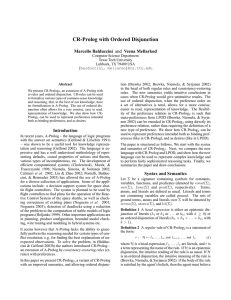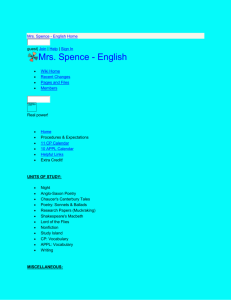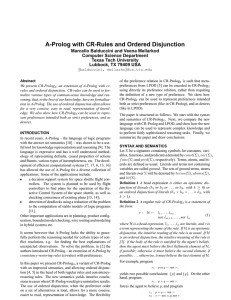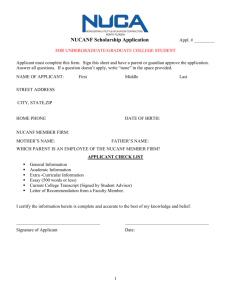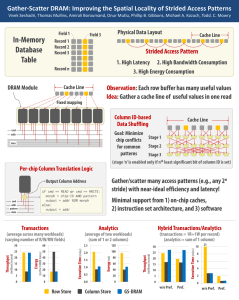CR-Prolog : CR-Prolog with Ordered Disjunction 2 Marcello Balduccini and Veena Mellarkod
advertisement
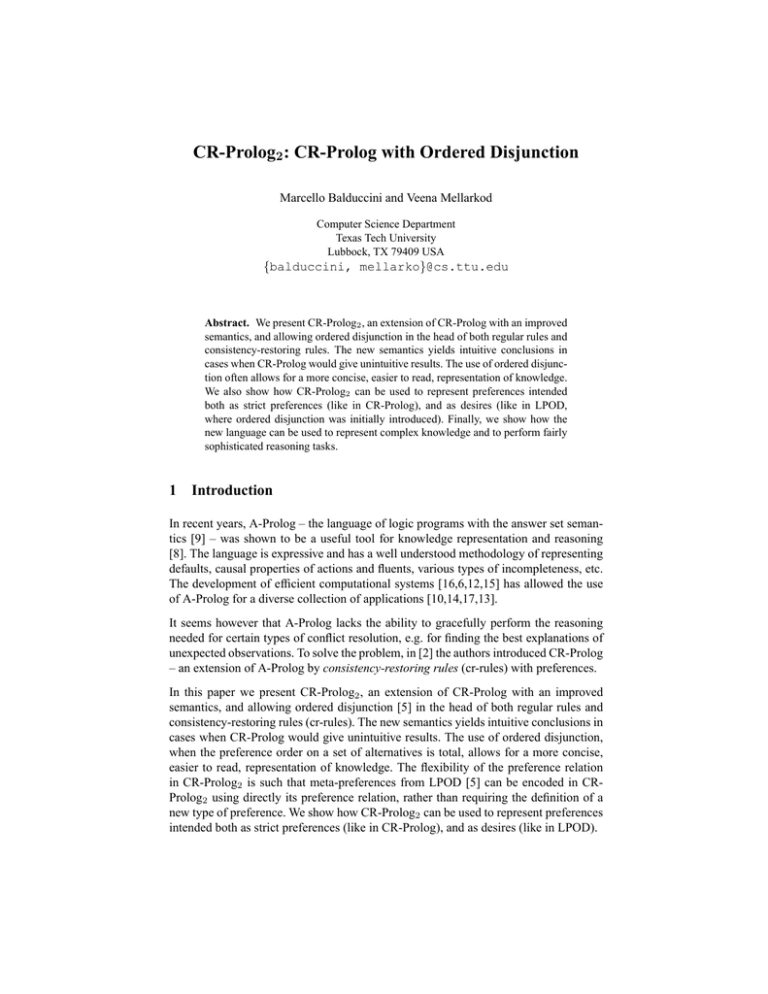
CR-Prolog2 : CR-Prolog with Ordered Disjunction
Marcello Balduccini and Veena Mellarkod
Computer Science Department
Texas Tech University
Lubbock, TX 79409 USA
{balduccini, mellarko}@cs.ttu.edu
Abstract. We present CR-Prolog2 , an extension of CR-Prolog with an improved
semantics, and allowing ordered disjunction in the head of both regular rules and
consistency-restoring rules. The new semantics yields intuitive conclusions in
cases when CR-Prolog would give unintuitive results. The use of ordered disjunction often allows for a more concise, easier to read, representation of knowledge.
We also show how CR-Prolog2 can be used to represent preferences intended
both as strict preferences (like in CR-Prolog), and as desires (like in LPOD,
where ordered disjunction was initially introduced). Finally, we show how the
new language can be used to represent complex knowledge and to perform fairly
sophisticated reasoning tasks.
1 Introduction
In recent years, A-Prolog – the language of logic programs with the answer set semantics [9] – was shown to be a useful tool for knowledge representation and reasoning
[8]. The language is expressive and has a well understood methodology of representing
defaults, causal properties of actions and fluents, various types of incompleteness, etc.
The development of efficient computational systems [16,6,12,15] has allowed the use
of A-Prolog for a diverse collection of applications [10,14,17,13].
It seems however that A-Prolog lacks the ability to gracefully perform the reasoning
needed for certain types of conflict resolution, e.g. for finding the best explanations of
unexpected observations. To solve the problem, in [2] the authors introduced CR-Prolog
– an extension of A-Prolog by consistency-restoring rules (cr-rules) with preferences.
In this paper we present CR-Prolog2 , an extension of CR-Prolog with an improved
semantics, and allowing ordered disjunction [5] in the head of both regular rules and
consistency-restoring rules (cr-rules). The new semantics yields intuitive conclusions in
cases when CR-Prolog would give unintuitive results. The use of ordered disjunction,
when the preference order on a set of alternatives is total, allows for a more concise,
easier to read, representation of knowledge. The flexibility of the preference relation
in CR-Prolog2 is such that meta-preferences from LPOD [5] can be encoded in CRProlog2 using directly its preference relation, rather than requiring the definition of a
new type of preference. We show how CR-Prolog2 can be used to represent preferences
intended both as strict preferences (like in CR-Prolog), and as desires (like in LPOD).
The paper is structured as follows. We start with the syntax and semantics of CRProlog2 . Next, we compare the new language with CR-Prolog and LPOD, and show
how the new language can be used to represent complex knowledge and to perform
fairly sophisticated reasoning tasks. Finally, we summarize the paper and draw conclusions.
2 Syntax and Semantics
Let Σ be a signature containing symbols for constants, variables, functions, and predicates (denoted by const(Σ), var(Σ), f unc(Σ) and pred(Σ), respectively). Terms,
atoms, and literals are defined as usual. Literals and terms not containing variables are
called ground. The sets of ground terms, atoms and literals over Σ will be denoted by
terms(Σ), atoms(Σ), and lit(Σ).
Definition 1. A head expression is either an epistemic disjunction of literals (h1 or h2 or
. . . or hk , with k ≥ 0) or an ordered disjunction of literals (h1 × h2 × . . . × hk , with
k > 1).
Definition 2. A regular rule of CR-Prolog2 is a statement of the form:
r : H ← l1 , . . . , lm ,
not lm+1 , . . . , not ln
(1)
where H is a head expression, l1 , . . . , ln are literals, and r is a term representing the
name of the rule. If H is an epistemic disjunction, the intuitive reading of the rule is
as usual. If H is an ordered disjunction, the intuitive meaning of the rule is [5]: if the
body of the rule is satisfied by the agent’s beliefs, then the agent must believe the first
(leftmost) element of H, if possible; otherwise it must believe the second element, if
possible; . . . otherwise, it must believe the last element of H.
For example, program
p or q ← not r.
yields two possible conclusions: {p} and {q}. On the other hand, program
p × q ← not r.
forces the agent to believe p, and program
p × q ← not r.
s ← not s, p, not r.
forces the agent to believe q (since believing p is made impossible by the second rule).
Definition 3. A cr-rule is a statement of the form:
+
r : H ← l1 , . . . , lm ,
not lm+1 , . . . , not ln
(2)
where r is the name of the rule, H is a head expression, and l1 , . . . , ln are literals. The
rule says that if l1 , . . . , lm belong to a set of agent’s beliefs and none of lm+1 , . . . , ln
belongs to it then the agent “may possibly” believe one of the elements of the head
expression. This possibility is used only if the agent has no way to obtain a consistent
set of beliefs using regular rules only. If H is an ordered disjunction, the preference
order that the agent uses to select an element from the head expression goes from left
to right, as for regular rules. If H is an epistemic disjunction, then all the elements are
equally preferable.
For example, program
+
p or q ← not r
s.
only forces the agent to believe s (the cr-rule need not be applied, since the program
containing only the second rule is consistent). On the other hand, program
+
p or q ← not r
s.
← not p, not q.
forces the agent to believe either {s, p} or {s, q}. If finally we want the agent to prefer
conclusion p to conclusion q when possible, we write
+
p × q ← not r
s.
← not p, not q.
which yields a unique set of beliefs, {s, p}. Notice though that adding new information
to the above program, for example a new rule ← p, forces the agent to retract the
previous conclusions, and believe {s, q}.
We will use the term rule to denote both regular rules and cr-rules. As usual, non-ground
rules are intended as schemata for their ground counterparts.
Definition 4. Preferences between cr-rules are expressed by atoms of the form
pref er(r1 , r2 ). If all preferences in a program are expressed as facts, we say that the
program employs static preferences. Otherwise, preferences are dynamic.
Definition 5. A CR-Prolog2 program, Π, is a pair hΣ, Ri consisting of signature Σ and
a set R of rules of form (1) or (2). We require that f unc(Σ) does not contain choice, and
that pred(Σ) contains pref er and does not contain appl, f ired, and is pref erred.
Signature Σ is denoted by sig(Π); const(Π), f unc(Π), pred(Π), atoms(Π) and
lit(Π) are shorthands for const(sig(Π)), f unc(sig(Π)), pred(sig(Π)), atoms(sig(Π))
and lit(sig(Π)), respectively. Let P be a set of predicate symbols from Σ. By atoms(Π, P )
we denote the set of all atoms from atoms(Π) formed by predicate symbols from P .
(Whenever possible we drop the first argument and simply write atoms(P )). The set
of rules of Π is denoted by rules(Π). If ρ is a rule of Π then head(ρ) = H, and
body(ρ) = {l1 , . . . , lm , not lm+1 , . . . , not ln }.
Programs of CR-Prolog2 are closely related to abductive logic programs [11,7] – pairs
hΠ, Ai where Π is a program of A-Prolog and A is a set of atoms, called abducibles1 .
1
Recall that the semantics of an abductive program is given by the notion of generalized answer
set – an answer set M (∆) of Π ∪ ∆ where ∆ ⊆ A; M (∆1 ) < M (∆2 ) if ∆1 ⊂ ∆2 . We
refer to an answer set as minimal if it is minimal with respect to this ordering.
The semantics of the language is based on a transformation hr(Π) of its programs into
abductive programs.
Definition 6. The hard reduct hr(Π) = hHΠ , atoms(HΠ , {appl})i is defined as follows:
1. let N be a set of new constant symbols, such that every element of N is uniquely
associated with an atom from sig(Π). We will denote the constant associated with
atom a by na ;
2. sig(HΠ ) extends sig(Π) so that: const(HΠ ) = const(Π) ∪ N , f unc(HΠ ) =
f unc(Π) ∪ {choice}, and pred(HΠ ) = pred(Π) ∪ {appl, f ired, is pref erred}.
3. let RΠ be set of rules obtained from Π by replacing every cr-rule, ρ, with a rule:
r : head(ρ) ← body(ρ), appl(r)
where r is the name of ρ. Notice that RΠ contains only regular rules;
4. the set of rules of HΠ is obtained from RΠ by replacing every rule, ρ, such that
head(ρ) = h1 × h2 × . . . × hk , with the following rules: (r is the name of rule ρ)
(a)
(b)
(c)
(d)
hi ← body(ρ), appl(choice(r, nhi )) for 1 ≤ i ≤ k;
f ired(r) ← appl(choice(r, nhi )) for 1 ≤ i ≤ k;
pref er(choice(r, nhi ), choice(r, nhi+1 )) for 1 ≤ i < k;
← body(ρ), not f ired(r).
5. HΠ also contains the following set of rules, denoted by Πp :
8
% transitive closure of predicate prefer
>
>
>
>
m1a : is pref erred(R1, R2) ← pref er(R1, R2).
>
>
>
>
m
>
> 1b : is pref erred(R1, R2) ← pref er(R1, R3),
>
>
is pref erred(R3, R2).
<
% no circular preferences
>
>
m2 : ← is pref erred(R, R).
>
>
>
>
% prohibit application of R1 and R2 if
>
>
>
>
>
% R1 is preferred to R2
>
:
m3 : ← appl(R1), appl(R2), is pref erred(R1, R2).
Let us compute the hard reduct of the following program:
Π1
8
>
r1 : p ← not q.
>
>
<
r5 : ← p, r.
r3 : q ← t.
>
>
>
: r4 : s ← t.
r6 : q × s ← .
+
r7 : t ← .
r2 : r ← not s.
+
0
0
HΠ1 = HΠ
∪ Πp , where HΠ
is:
1
1
8
>
>
r1 : p ← not q.
>
>
>
>
r2 : r ← not s.
>
>
<
r3 : q ← t.
r4 : s ← t.
>
>
>
>
>
>
>
>
: r5 : ← p, r.
1
r6a
2
r6a
1
r6b
2
r6b
r6c
r6d
r70
:
q ← appl(choice(r6 , nq )), appl(r6 ).
:
s ← appl(choice(r6 , ns )), appl(r6 ).
: f ired(r6 ) ← appl(choice(r6 , nq )), appl(r6 ).
: f ired(r6 ) ← appl(choice(r6 , ns )), appl(r6 ).
: pref er(choice(r6 , nq ), choice(r6 , ns )).
:
← appl(r6 ), not f ired(r6 ).
:
t ← appl(r7 ).
The generalized answer sets of hr(Π1 ) are: (we omit the atoms formed by is pref erred
and f ired):
C1 = { pref er(choice(r6 , nq ), choice(r6 , ns )), C4 = {
appl(r6 ), appl(choice(r6 , nq )), q, r}
C2 = { pref er(choice(r6 , nq ), choice(r6 , ns )),
appl(r6 ), appl(choice(r6 , ns )), s, p}
C5 = {
C3 = { pref er(choice(r6 , nq ), choice(r6 , ns )),
appl(r7 ), t, q, s}
pref er(choice(r6 , nq ), choice(r6 , ns )),
appl(r6 ), appl(choice(r6 , nq )), q, r,
appl(r7 ), t, s}
pref er(choice(r6 , nq ), choice(r6 , ns )),
appl(r6 ), appl(choice(r6 , ns )), q,
appl(r7 ), t, s}
Intuitively, not all the generalized answer sets appear equally appealing w.r.t the preferences expressed in the program. The following definition formalizes this idea.
Definition 7. Let Π be a CR-Prolog2 program, and C, C 0 be generalized answer sets
of hr(Π). We say that C dominates C 0 (and write C Â C 0 ) if:
∃appl(r1 ) ∈ C, appl(r2 ) ∈ C 0 s.t.
is pref erred(r1 , r2 ) ∈ C ∩ C 0 .
(3)
To see how this definition works, let us apply it to the generalized answer sets of program Π1 above. According to Equation (3), C1 Â C2 . In fact appl(choice(r6 , nq ))
belongs to C1 , appl(choice(r6 , ns )) belongs to C2 , and pref er(choice(r6 , nq ),
choice(r6 , ns )) belongs to C1 and C2. In a similar way, C4 Â C5 .
If a generalized answer set is dominated by another, it means that it is not as “good” as
the other w.r.t. some preference contained in the program. Consider C2 , for example:
since it is dominated by C1 , the intuition suggests that C2 should be excluded from the
belief sets of the agent. Generalized answer sets that are equally acceptable w.r.t. the
preferences are called candidate answer sets, as stated by the next definition.
Definition 8. Let Π be a CR-Prolog2 program, and C be a generalized answer set of
hr(Π). We say that C is a candidate answer set of Π if there exists no generalized
answer set, C 0 , of hr(Π) such that C 0 Â C.
Hence, C2 and C5 above are not candidate answer sets of Π1 , while C1 , C3 , and C4
are. Now let us compare C1 and C4 . Set C1 is obtained by abducing appl(r6 ) and
appl(choice(r6 , ns )). Set C4 is obtained by abducing appl(r6 ), appl(choice(r6 , ns ))
and appl(r7 ). According to the intuition, appl(r7 ) is abduced unnecessarily, which
makes C4 less acceptable than C1 . We discard belief sets such as C4 by applying a
minimality criterion based on set-theoretic inclusion on the abducibles present in each
set. The remaining sets are the answer sets of the program.
Definition 9. Let Π be a CR-Prolog2 program, and C be a candidate answer set of Π.
We say that C ∩ lit(Π) is an answer set of Π if there exists no candidate answer set,
C 0 , of Π such that C 0 ∩ atoms({appl}) ⊂ C.
Since C1 ∩ atoms({appl}) ⊂ C4 , C4 ∩ lit(Π1 ) is not an answer set of Π1 . In conclusion, the answer sets of Π1 are C1 ∩ lit(Π1 ) and C3 ∩ lit(Π1 ).
Let us apply the above definitions to compute the answer sets of some sample programs.
Example 1. Consider the following program:
Π2
8
< r1 : p ← r, not q.
:
r2 : r.
+
r3 : s ← r.
Intuitively, r3 should not be applied, since program Π2 \ {r3 } is consistent. Hence, the
only answer set of Π2 should be {p, r}. Let us check that this intuition is captured by
0
0
∪ Πp , where HΠ
is:
our definition. The first element of hr(Π2 ) is HΠ2 = HΠ
2
2
0
HΠ
2
8
< r1 : p ← r, not q.
:
r2 : r.
r30 : s ← r, appl(r3 ).
The generalized answer sets of hr(Π2 ) are C1 = {p, r} and C2 = {p, r, s, appl(r3 )}.
Since the program does not contain preferences, C1 and C2 are the candidate answer sets of Π2 . Notice that C2 ∩ lit(Π2 ) is not an answer set of Π2 , since C1 ∩
atoms({appl}) ⊂ C2 . Hence, C1 is the only answer set of Π2 .
Example 2. Consider the following program:
Π3
8
r1 : a ← p.
>
>
<
r2 : a ← r.
r3 : b ← q.
>
>
:
r4 : b ← s.
+
r5a : ← not a.
r5b : ← not b.
r6 : p × q ← .
+
r7 : r × s ← .
The generalized answer sets of hr(Π3 ) are:
C1 = { pref er(choice(r6 , np ), choice(r6 , nq )), C2 = {
pref er(choice(r7 , nr ), choice(r7 , ns )),
appl(choice(r6 , np )),
appl(choice(r7 , ns )), p, s, a, b}
pref er(choice(r6 , np ), choice(r6 , nq )),
pref er(choice(r7 , nr ), choice(r7 , ns )),
appl(choice(r7 , nr )),
appl(choice(r6 , nq )), r, q, a, b}
Since C1 Â C2 and C2 Â C1 , Π3 has no answer sets.
As the reader may have noticed, the names of rules can be safely omitted when they
are not used to specify preferences. In the rest of the paper, we will omit them when
possible.
3 CR-Prolog2 and CR-Prolog
CR-Prolog2 has two main advantages over CR-Prolog: the availability of ordered disjunction and the improved semantics, which solves some problems present in the semantics of CR-Prolog.
Ordered disjunction allows for a more concise, easier to read, representation of knowledge when the preference order on a set of alternatives is total. Consider the following
program:
8
>
r1 : eat(meat)
>
>
>
>
< r2 : eat(rice)
+
←.
+
←.
+
> r3 : eat(cracker) ← .
>
>
>
pref er(r1 , r2 ).
>
:
pref er(r2 , r3 ).
eat
← eat(X).
starve ← hungry, not eat.
← starve.
Since the preference order between the cr-rules is total, the program can be quite simplified by introducing ordered disjunction:
8
+
>
eat(meat) × eat(rice) × eat(cracker) ← .
>
<
eat ← eat(X).
>
starve ← hungry, not eat.
>
:
← starve.
Moreover, ordered disjunction can be used to concisely represent a set of alternatives
among which one must be chosen. It may be instructive to compare how A-Prolog, CRProlog, and CR-Prolog2 can be used in this context. Suppose we want to encode the
statement
“normally, hard-working graduate students
receive A in the courses they take.”
(4)
We might simply represent it with a default:
received(S, a, C) ← hard working(S), took(S, C),
not ¬received(S, a, C).
Consider now the additional information “Frank is an hard-working student, but he
took AI, and did not receive A”. It would seem natural to conclude that Frank probably
received a B, but our simple representation of (4) does not yield this conclusion. Writing
in A-Prolog a set of defaults that embodies the common-sense knowledge about this
domain can prove tedious. A possible solution is:
8
better grade(a, b).
better grade(b, c).
>
>
>
>
received(S,
G1,
C)
←
hard
working(S), took(S, C),
>
>
>
>
not ¬received(S, G1, C),
<
better grade(G2, G1),
>
>
¬received(S, G2, C).
>
>
>
>
received(S,
a,
C)
←
hard
working(S), took(S, C),
>
>
:
(5)
not ¬received(S, a, C).
The first rule says that, normally, an hard-working student takes grade G1 in the courses
he attends, unless he takes a better grade. The second rule is needed because the previous statement does not apply to grade A, as there is no better grade than that. 2 Given
the information:
8
< hard working(f rank).
:
took(f rank, ai).
¬received(f rank, a, ai).
(6)
the program correctly concludes received(f rank, b, ai). On the other hand, if information is represented as:
8
< hard working(f rank).
:
took(f rank, ai).
← received(f rank, a, ai).
(7)
the program still fails to yield the intuitive conclusion.
2
Several options are possible in order to avoid writing the second default, but none of them
seems completely satisfactory.
A better way to solve the problem is offered by CR-Prolog. Consider the following
program:
8
+
>
r(S, G, C) : received(S, G, C) ← took(S, C).
>
>
>
>
>
>
>
< pref er(r(S, a, C), r(S, b, C)) ← hard working(S).
pref er(r(S, b, C), r(S, c, C)) ← hard working(S).
>
>
>
>
>
>
>
had grade(S, C) ← received(S, G, C).
>
:
(8)
← took(S, C), not had grade(S, C).
This program yields the expected conclusion with both (6) and (7).
Now let us consider a possible CR-Prolog2 representation of (4):
8
< received(S, a, C)×
:
received(S, b, C)×
received(S, c, C) ← took(S, C), hard working(S).
(9)
It is easy to see that this program yields the desired conclusion independently of whether
the extra information is given in form (6) or (7). Moreover, the program is, in our opinion, easier to understand than the previous ones.3
Not only CR-Prolog2 is often more concise than CR-Prolog: it also allows to derive the
correct conclusions in cases when CR-Prolog returns unintuitive conclusions. To understand when CR-Prolog may give unintuitive results, consider the following situation:
“We need to take full-body exercise. Full-body exercise is achieved
either by combining swimming and ball playing, or by combining
weight lifting and running. We prefer running to swimming and ball
playing to weight lifting, but we are willing to ignore our preferences,
if that is the only way to obtain a solution to the problem.”
(10)
According to the intuition, the problem has no solution unless preferences are ignored.
In fact, we can either combine weight lifting and running, or combine swimming and
ball playing, but each option is at the same time better and worse than the other according to different points of view.4 If preferences are ignored, both combinations are
acceptable.
3
4
It is worth noticing that, although ordered disjunction provides a concise representation, it cannot entirely replace the use of cr-rules. For example, (8) allows us to derive the grade received
by graduate students who are not hard-working, while (9) does not yield any conclusion about
them.
Both alternatives are valid if we intend preferences as desires, instead of strict preferences. See
the next section for a discussion on this topic.
Statement (10) can be encoded by the following program, Π4 :
8
+
>
rr : run ← .
>
>
>
+
>
>
rs : swim ← .
>
>
>
+
>
rp : play ball ← .
>
>
>
+
>
>
rw : lif t weights ← .
>
>
>
>
>
<
f ull body exercise ← lif t weights, run.
>
>
f ull body exercise ← swim, play ball.
>
>
> ← not f ull body exercise.
>
>
>
>
>
>
>
>
> pref er(rr , rs ) ← not ignore pref s.
>
>
> pref er(r , r ) ← not ignore pref s.
>
p w
>
>
:
+
rz : ignore pref s ← .
The generalized answer sets of hr(Π4 ) are: (we show only the atoms formed by run,
swim, play ball, lif t weights, ignore pref s, and pref er)
G1
G2
G3
G4
G5
G6
G7
G7
G8
: {lif t weights, run, pref er(rr , rs ), pref er(rp , rw )}
: {swim, play ball, pref er(rr , rs ), pref er(rp , rw )}
: {ignore pref s, lif t weights, run}
: {ignore pref s, swim, play ball}
: {ignore pref s, lif t weights, run, swim}
: {ignore pref s, lif t weights, run, play ball}
: {ignore pref s, swim, play ball, lif t weights}
: {ignore pref s, swim, play ball, run}
: {ignore pref s, lif t weights, run, swim, play ball}
Under the semantics of CR-Prolog, G1 and G2 are the only minimal generalized answer
sets. Since G1 Â G2 and G2 Â G1 , Π4 has no answer sets.
Under the semantics of CR-Prolog2 , G1 and G2 dominate each other, which leaves
only G3 , . . . , G8 as candidate answer sets. Since G3 and G4 are both minimal w.r.t. the
abducibles present in each candidate answer set, they are both answer sets of Π4 , like
intuition suggested.
The reason for this difference is that, in the semantics of CR-Prolog, set-theoretic minimization occurs before the comparison of belief sets w.r.t. the preferences. In CRProlog2 , on the other hand, generalized answer sets are first of all compared w.r.t. the
preference relation, and only later set-theoretic minimization is applied. In our opinion,
giving higher relevance to the preference relation is a better choice (as confirmed by the
previous example), since preferences are explicitly given by the programmer.
4 Comparison with LPOD
In [4], the author introduces logic programs with ordered disjunction (LPOD). The
semantics of LPOD is based on the notion of preferred answer sets. In a later paper [5],
the authors introduce the notion of Pareto-preference between belief sets and show that
this criterion gives more intuitive results that the other criteria described in [4,5]. In this
section, we compare LPOD (under Pareto-preference) and CR-Prolog2 .
Consider program Πs1 from [5]:
8
% Ice cream is preferred to cake.
>
>
>
>
>
> r1 : ice cream × cake.
<
% Coffee is preferred to tea.
r2 : cof f ee × tea.
>
>
>
>
% We cannot have ice cream and cake together.
>
>
:
← ice cream, cof f ee.
The preferred answer sets of Πs1 in LPOD are:
{ice cream, tea} and {cake, cof f ee}.
(11)
There are no answer sets of Πs1 according to the semantics of CR-Prolog2 . The difference between the two semantics depends on the fact that Pareto optimality was introduced to satisfy desires and it looks for a set of solutions that satisfy as many desires
as possible. On the other hand, our preference criterion corresponds to a more strict
reading of the preferences.
In order to make it easy to understand the relationship between the two types of preference, we restate the Pareto criterion in the context of CR-Prolog2 .
Definition 10. Let Π be a CR-Prolog2 program, and C, C 0 be generalized answer sets
of hr(Π). We say that C Pareto-dominates C 0 (written as C Âp C 0 ), if
∃appl(r1 ) ∈ C, appl(r2 ) ∈ C 0 s.t.
is pref erred(r1 , r2 ) ∈ C ∩ C 0 , and
(12)
¬ ∃appl(r3 ) ∈ C, appl(r4 ) ∈ C 0 s.t.
is pref erred(r4 , r3 ) ∈ C ∩ C 0 .
Definition 11. Let Π be a CR-Prolog2 program, C be a generalized answer set of
hr(Π). We say that C is a Pareto-candidate answer set of Π if there exists no generalized answer set, C 0 , of hr(Π) such that C 0 Âp C.
(Notice that Pareto-domination is essentially a restatement of the Pareto criterion, in
the context of CR-Prolog2 . Also, Pareto-candidate answer sets essentially correspond
to preferred answer sets.)
Now, to see the difference between Definitions 7 and 10, consider a program, Π, and
generalized answer sets, C1 and C2 , such that C1 dominates C2 and vice-versa. Notice
that they do not Pareto-dominate each other. Under our semantics, none of them is a
candidate answer set of Π. However, using Pareto-domination, C1 and C2 are incomparable and thus, both are eligible as Pareto-candidate answer sets (whether they really
are Pareto-candidate answer sets, depends on the other generalized answer sets).
In a sense, Definition 7 enforces a clearer representation of knowledge and of preferences. However, that does not rule out the possibility of representing desires in CRProlog2 . The defeasible nature of desires is represented by means of cr-rules. For example, the program Πs1 can be rewritten as follows, Πs2 :
8
>
>
>
>
>
>
>
>
>
>
>
>
>
>
>
>
>
<
r1a :
r1b :
r2a :
r2b :
←
+
ice cream ← .
+
cake ← .
+
cof f ee ← .
+
tea ← .
ice cream, cof f ee.
solid ← ice cream.
solid ← cake.
liquid ← cof f ee.
liquid ← tea.
← not solid.
← not liquid.
>
>
>
>
>
r3 : pref er(r1a , r1b ) ← not ¬pref er(r1a , r1b ).
>
>
>
>
r4 : pref er(r2a , r2b ) ← not ¬pref er(r2a , r2b ).
>
>
>
+
>
>
r5 : ¬pref er(r1a , r1b ) ← .
>
>
>
+
:
r6 : ¬pref er(r2a , r2b ) ← .
In Πs2 , the desire to have ice cream over cake is represented by:
– a cr-rule, r5 , that says that, “the agent may possibly give up his preference for
ice cream over cake”.
– a default, r3 , saying that, “the agent normally prefers ice cream over cake”.
In a similar way, we represent the desire for coffee over tea. The answer sets of the
above program are (we show only the atoms from cr-rules r1a -r2b ) {ice cream, tea}
and {cake, cof f ee}, which correspond to (11).
Now suppose that we are more inclined to give up the preference about coffee and
tea rather than the preference about ice cream and cake. In the language of LPOD,
such priorities over rules are represented by the meta-preference relation >.5 The above
information is represented by adding to Πs1 the rule r5 > r6 , which says that r5 is
preferred to r6 .
Adding the same type of knowledge using CR-Prolog2 is, in our opinion, more straightforward, because it does not require the introduction of a new type of preference relation in the language.6 The above information is represented in CR-Prolog2 by adding
to Πs2 the rule pref er(r6 , r5 ), which says that belief sets obtained by giving up the
preference on coffee and tea are more acceptable than the belief sets obtained by giving
up the preference on ice cream and cake.
There are also some programs for which the semantics of LPOD seems to yield unintuitive results, while the semantics of CR-Prolog2 gives results that agree with the
intuition. Consider the following example:7
5
6
7
The connective used in [5] is Â. In this paper we replace  by > to avoid confusion with the
symbol introduced in Definition 7.
It is still not sure if the two approaches are entirely equivalent. A thorough comparison is under
way.
We thank Richard Watson for noticing the problem with LPOD and suggesting the example.
Example 3. “John prefers to go to a movie over watching tv. If he goes to the movies
then he prefers eating popcorn over candy. Now popcorn is not available.”
8
>
> % John prefers to go to a movie over watching tv.
>
>
movie × tv.
>
>
<
% At the movies, he prefers eating popcorn over candy.
popcorn × candy ← movie.
>
>
>
>
> % Popcorn is not available.
>
:
¬popcorn.
Intuitively, John should prefer going to the movies. Since popcorn is not available, he
will eat candy. Watching tv seems a less acceptable option. Under the LPOD semantics,
however, the above program has two answer sets: {movie, candy} and {tv}, in contrast
to the intuition. The same program under CR-Prolog2 semantics gives only one answer
set, {movie, candy}, which corresponds to the intuitive result. (The unintuitive result
by LPOD, we believe, may be caused by the fact that degree 1 is assigned to rules whose
body is not satisfied.)
5 Applications of CR-Prolog2
CR-Prolog2 can be used to encode types of common-sense knowledge which, to the
best of our knowledge, have no natural formalization in A-Prolog. In this section, we
give an example of such use, and show how the alternative formalization in CR-Prolog
is less elegant and concise.
In the example that follows we consider a diagnostic reasoning task performed by an
intelligent agent acting in dynamic domains in the sense of [3]. Since space limitations
do not allow us to give a complete introduction on the modeling of dynamic systems in
A-Prolog and its extensions, we refer the reader to [1,2] for details on the formalization
used.
Example 4. “A car’s engine starts when the start key is turned, unless there is a failure
with some equipment responsible for starting the engine. There can be electrical failures, such as battery down or fuse burnt; or mechanical failures, such as clutch sensor
stuck or belt loose. In general, the electrical failures are more likely than the mechanical failures. Among the electrical failures, battery down is more likely than fuse burnt.
Among the mechanical failures, clutch sensor stuck is more likely than belt loose.”
The knowledge contained in this story can be represented by the following action description, Πc :
8
% normally, a car’s engine starts when the start key is turned,
>
>
>
>
% unless there is a failure in start equipment.
>
>
>
>
< h(engine on, T + 1) ← o(turn key, T ),
¬h(ab(start equip), T ).
>
>
>
>
>
>
% battery being down causes failure in start equipment.
>
>
:
h(ab(start equip), T ) ← h(battery down, T ).
8
% fuse being burnt causes failure in start equipment.
>
>
>
>
h(ab(start equip), T ) ← h(f use burnt, T ).
>
>
>
>
>
>
>
>
>
% clutch sensor stuck causes failure in start equipment.
>
>
>
>
h(ab(start equip), T ) ← h(sensor stuck, T ).
>
>
>
>
>
>
>
>
% belt being loose causes failure in start equipment.
>
>
>
>
h(ab(start equip), T ) ← h(belt loose, T ).
>
>
>
>
>
>
>
>
% sometimes, battery is down or fuse is burnt,
>
>
>
>
% the former being more likely than the latter
>
>
>
+
>
> relec (T ) : h(battery down, T ) × h(f use burnt, T ) ←
.
>
>
>
>
>
>
>
>
> % sometimes, clutch sensor is stuck or belt is loose,
>
<
% the former being more likely than the latter
+
>
rmech (T ) : h(sensor stuck, T ) × h(belt loose, T ) ← .
>
>
>
>
>
>
>
>
% electrical failures are more likely than mechanical failures
>
>
>
>
rp (T ) :
pref er(relec (T ), rmech (T )).
>
>
>
>
>
>
>
>
>
% INERTIA
>
>
>
>
h(F, T + 1) ← h(F, T ), not ¬h(F, T + 1).
>
>
>
>
¬h(F, T + 1) ← ¬h(F, T ), not h(F, T + 1).
>
>
>
>
% REALITY CHECKS
>
>
>
>
← obs(F, T ), not h(F, T ).
>
>
>
>
← obs(¬F, T ), not ¬h(F, T ).
>
>
>
>
%
AUXILIARY
AXIOMS
>
>
>
>
o(A, T ) ← hpd(A, T ).
>
>
>
>
h(F, 0) ← obs(F, 0).
>
>
:
¬h(F, 0) ← obs(¬F, 0).
Let us add the following history to the action description:
8
< obs(¬engine on, 0). % CWA on initial observations
:
hpd(turn key, 0).
obs(¬F, 0) ← not obs(F, 0).
obs(¬engine on, 1).
The observation at time 1 is unexpected, and causes the program to be inconsistent
(because of the reality checks), unless at least one cr-rule is applied; because of the
preference encoded by rp (T ), the preferred way to restore consistency is by applying
relec (0); of the two options contained in the head of relec (0), h(battery down, 0) is
the preferred one. Clearly, adding the belief h(battery down, 0) restores consistency
of the program, and explains the unexpected observation.
It is worth noticing that the statements encoded by rules relect (T ), rmech (T ) and rp (T )
of Πc can be also represented without ordered disjunction. The three rules are replaced
by:
8
+
rbatt (T ) : h(battery down, T ) ← hyp elec(T ).
>
>
>
+
<
rf use (T ) : h(f use burnt, T )
← hyp elec(T ).
+
>
rsens (T ) : h(sensor stuck, T ) ← hyp mech(T ).
>
>
:
+
rbelt (T ) : h(belt loose, T )
← hyp mech(T ).
8
>
>
>
>
>
>
<
pref er(rbatt (T ), rf use (T )).
pref er(rsens (T ), rbelt (T )).
+
relec (T ) : hyp elec(T ) ← .
>
>
+
>
>
r
>
mech (T ) : hyp mech(T ) ← .
>
:
pref er(relec (T ), rmech (T )).
The new program has (essentially) the same answer sets as the previous one. This shows
that the rules with ordered disjunction allow for a more concise and elegant representation of knowledge.
6 Conclusions
In this paper, we extended CR-Prolog by ordered disjunction and an improved semantics, gave the semantics of the new language, and demonstrated how it differs from CRProlog and LPOD. We also showed how CR-Prolog2 can be used to formalize various
types of common-sense knowledge and reasoning. We could not find natural A-Prolog
formalizations for some of the examples in the paper, and formalizations in CR-Prolog
were often less elegant and concise (besides giving sometimes unintuitive results). In
comparison with CR-Prolog, we believe that the new features of CR-Prolog2 make it
possible to write formalizations that are more natural, and reasonably elaboration tolerant. In comparison with LPOD, CR-Prolog2 appears more expressive (because of the
availability of cr-rules and epistemic disjunction), and, in some cases, yields more intuitive results than LPOD.
7 Acknowledgments
The authors are very thankful to Micheal Gelfond for his suggestions. This work was
partially supported by United Space Alliance under Research Grant 26-3502-21 and
Contract COC6771311, and by NASA under grant NCC9-157.
References
1. Marcello Balduccini and Michael Gelfond. Diagnostic reasoning with a-prolog. Journal of
Theory and Practice of Logic Programming (TPLP), 3(4–5):425–461, Jul 2003.
2. Marcello Balduccini and Michael Gelfond. Logic programs with consistency-restoring rules.
In Patrick Doherty, John McCarthy, and Mary-Anne Williams, editors, International Symposium on Logical Formalization of Commonsense Reasoning, AAAI 2003 Spring Symposium
Series, Mar 2003.
3. Chitta Baral and Michael Gelfond. Reasoning agents in dynamic domains. In Workshop on
Logic-Based Artificial Intelligence. Kluwer Academic Publishers, Jun 2000.
4. Gerhard Brewka. Logic programming with ordered disjunction. In Proceedings of AAAI-02,
2002.
5. Gerhard Brewka, Ilkka Niemela, and Tommi Syrjanen. Implementing ordered disjunction
using answer set solvers for normal programs. In Sergio Flesca and Giovanbattista Ianni,
editors, Proceedings of the 8th European Conference on Artificial Intelligence (JELIA 2002),
Sep 2002.
6. Francesco Calimeri, Tina Dell’Armi, Thomas Eiter, Wolfgang Faber, Georg Gottlob, Giovanbattista Ianni, Giuseppe Ielpa, Christoph Koch, Nicola Leone, Simona Perri, Gerard Pfeifer,
and Axel Polleres. The dlv system. In Sergio Flesca and Giovanbattista Ianni, editors, Proceedings of the 8th European Conference on Artificial Intelligence (JELIA 2002), Sep 2002.
7. Michael Gelfond. Epistemic approach to formalization of commonsense reasoning. Technical Report TR-91-2, University of Texas at El Paso, 1991.
8. Michael Gelfond. Representing knowledge in a-prolog. In Antonis C. Kakas and Fariba
Sadri, editors, Computational Logic: Logic Programming and Beyond, Essays in Honour of
Robert A. Kowalski, Part II, volume 2408, pages 413–451. Springer Verlag, Berlin, 2002.
9. Michael Gelfond and Vladimir Lifschitz. Classical negation in logic programs and disjunctive databases. New Generation Computing, pages 365–385, 1991.
10. K. Heljanko. Using logic programs with stable model semantics to solve deadlock and
reachability problems for 1-safe petri nets. Fundamenta Informaticae, 37(3):247–268, 1999.
11. Antonis C. Kakas and Paolo Mancarella. Generalized stable models: a semantics for abduction. In Proceedings of ECAI-90, pages 385–391. IOS Press, 1990.
12. Fangzhen Lin and Yuting Zhao. Assat: Computing answer sets of a logic program by sat
solvers. In Proceedings of AAAI-02, 2002.
13. Monica Nogueira. Building Knowledge Systems in A-Prolog. PhD thesis, University of Texas
at El Paso, May 2003.
14. Monica Nogueira, Marcello Balduccini, Michael Gelfond, Richard Watson, and Matthew
Barry. An a-prolog decision support system for the space shuttle. In Alessandro Provetti and
Son Cao Tran, editors, Answer Set Programming: Towards Efficient and Scalable Knowledge
Representation and Reasoning, AAAI 2001 Spring Symposium Series, Mar 2001.
15. Enrico Pontelli, Marcello Balduccini, and F. Bermudez. Non-monotonic reasoning on beowulf platforms. In Veronica Dahl and Philip Wadler, editors, PADL 2003, volume 2562 of
Lecture Notes in Artificial Intelligence (LNCS), pages 37–57, Jan 2003.
16. Patrik Simons. Computing Stable Models, Oct 1996.
17. Timo Soininen and Ilkka Niemela. Developing a declarative rule language for applications
in product configuration. In Proceedings of the First International Workshop on Practical
Aspects of Declarative Languages, May 1999.


